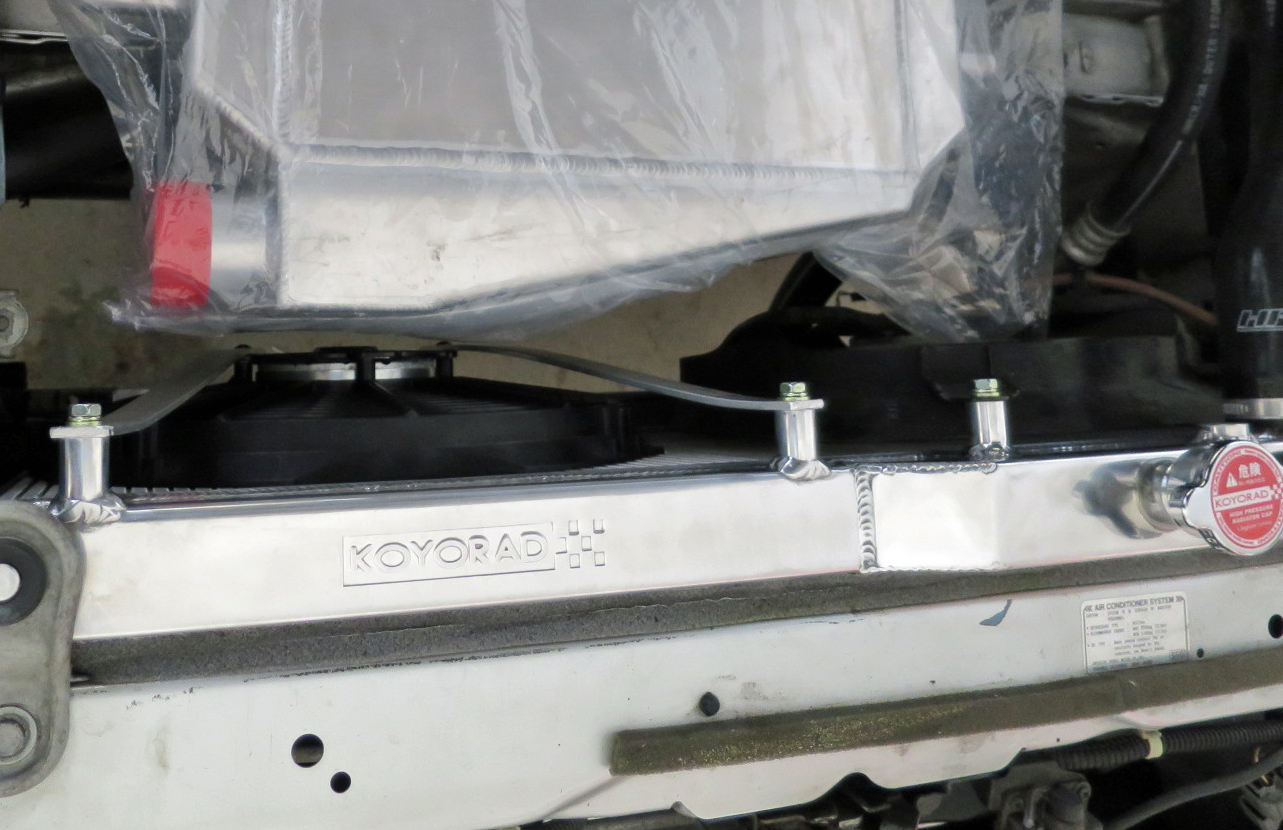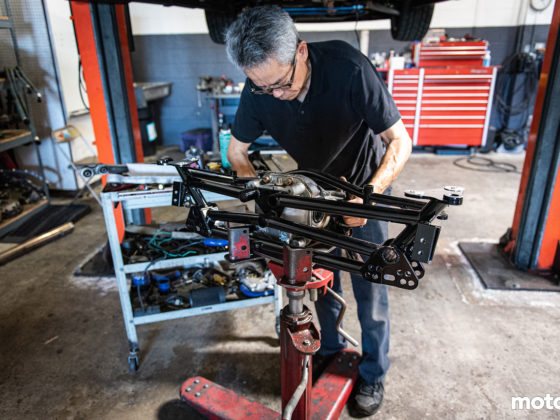
In addition to transferring over the temperature sensor, the lower radiator rubber bumper mounts transfer over too.

Look at all the new space! We gained 17mm from the new Koyo radiator and 70mm from the Spal fan for a total of about 87mm. That is just about 3.5 inches of newfound space.

The new space up front just freed up a lot of important space in front of the engine, especially around the oil filter. This is going to be a congested area where we have the turbocharger compressor inlet tube snaking through along with the remote oil filter adapter and oil lines bending around.

Angling the intercooler upwards at the front allows for air coming off the radiator to naturally flow underneath. I was planning on an air diverter plate to force the radiator air downward anyways, so I’m thinking this will be the rough orientation of the intercooler. If you can visualize in your head, a tube will go from the compressor outlet of the turbocharger underneath the engine bay cross member the intercooler is resting on, and then up to the 2-inch diameter hose barb of the intercooler. We’ll probably end up cutting off that barb and welding on a 90-degree elbow.

While testing the Spal fan, it blew out the 20A fuse for the stock fan even though the Spal is rated at 13A current draw. My guess is the initial startup of the fan has a big current in-rush that is blowing the fuse. I swapped in a 30A fuse as I read that’s what the PTuning kit does and the fan works no problem now. The wire gauge of the Spal fan is no bigger than the stock Honda fan and I am sure it’s just the initial fan start-up current in-rush that was blowing the 20A fuse, so no worries in my mind.




10 comments
I strongly disagree that the s2k has a tight engine bay… with the front of the engine being aligned with the axle line its got tons of space in the front end. its prolly got the most engine bay space of any similar car of similar vintage or newer… only thing I can think of with more are full size pickups with V6’s… and a Challenger with a V6, and those aren’t in a similar class.
-bitter NC owner (thats jealous of all that space you have) (and amazing engine)
You make a fair point! Uh… It’s very tight on the sides of the engine but lots of space in front? I think I’m still in cram in manifold mindset.
its still not bad, its a longitudinal 4, so kinda best case scenario… any V config has less space (except Challenger and trucks). Maybe we should all get Challengers and have all that engine bay space, haha
I’ve wrenched and dropped the engine of a Z32 twin turbo. I had blocked that memory out…
That engine is not hard to drop and so are most things working on it. Only working on the turbos is a fucker with the engine in the car.
I give that fan mounting 1/2 a track day life span. The fan cover screws are not meant to do any more than hold a piece of thin stamped sheet over a hole. Those are just screws threading into plastic and you have lost a fair bit of that thread depth due to the thickness of the aluminum strap. I’d suggest you find a solution that mounts to the fan frame as designed. If that holds the fan in place for a while it is still going to bounce against the radiator and do some damage.
Appreciate the feedback. I actually have good confidence in the durability of the strap setup because the screws are surprisingly long and the fan is pretty light. The screws are about 10mm long if my memory still works, and the strips are 1/8″ thick, so about 3mm. About 1mm for the cover, so there still should be about 6mm of tread engagement. That all said, I did google SPAL fan mounting brackets after your comment and SPAL makes some plastic pieces with metal straps that slide into the slots on the perimeter of the fans.
https://www.spalusa.com/products/fans/fan_accessories/fan-bracket-30130010-1-strap-kit-30130071-30130011?returnurl=%2fproducts%2ffans%2ffan_accessories%2f
How I didn’t find these things before, I have no clue. Way back, I was familiar with the zip-tie things that pull through the heat exchanger to hold the fan on and they suck. And these metal strap bracket combos are under $3 each. Well, time to upgrade.
That fan mounting does look sketchy, but it’s not really any different than there being a shroud that extends to those bolt holes. As long as the aluminum has sufficient stiffness against bending I’m sure it’d be fine. Having something decide the bottom of the fan would make me sleep better as I assume the problem would be the fan bouncing around and possibly ripping the aluminum strap.
Can’t wait to see this project come to a ‘finished’ state – sounds like it’s going to be an amazing do it all kinda machine.
I can’t believe people still going for ceramic coatings instead of heat wrap or newer, heat shielding technology. I saw way too many parts being melted because someone believed that ceramic coating is enough.
No it isn’t! It will still glow red and radiate enough thermal energy to melt everything that is made from plastic and it will even burn down WG membrane.
The SwainTech White Lightning Thermal Barrier is a motorsport grade coating, not just cosmetic like the majority of them out there. I’d put it a step above Zircotec even. Keep in mind that vast majority of OE applications just have bare manifold and turbine housing and a steel heat shield around it. I’m basically using the SwainTech as a replacement for the standard heat shield. Only on the the more performance oriented applications like Merc AMG, Porsche 911, do you see the inconel heat shielding wrap on the manifold and/or turbine housing. You’re everyday turbo gas engines in Kias, Hondas, Toyotas, Fords, BMWs, VW, Audis, etc just have basic heat shielding.
I personally chose to go this route for ease of installation (as opposed to a fully insulated inconel type wrap) along with being more cost effective. Type of application must also be taken into account. This car is no longer a beat on it hours on end, but for short bursts. Therefore, the more extensive heat shielding is not required. Keep in mind I also packaged the manifold relatively tight to the stock header heatshield that I am retaining so as to protect everything behind the heat shield (A/C lines, electrical boxes, battery, heater lines). I’m not sure I could fit an insulation manifold setup without a clash condition.
So the other part of the equation, as you eluded to with WG membrane failure, is airflow in the area of the turbo. Regardless of the type of coating on the manifold, it has nothing to do with the WG membrane failure. The membrane failure is due to a lack of cooling of the WG. Keep in mind the WG sees the hottest exhaust flow straight from the exhaust gas. There is also the direct heat conduction path, metal to metal, between the manifold and WG. Whatever radiation heat transfer from the manifold to WG is insignificant. If you read the instructions of any Turbosmart or Tial wastegate, it says they must get adequate cooling airflow. Or, you need to use one of their water-cooled variants to prevent failure. I’m planning to plumb some airflow back there.